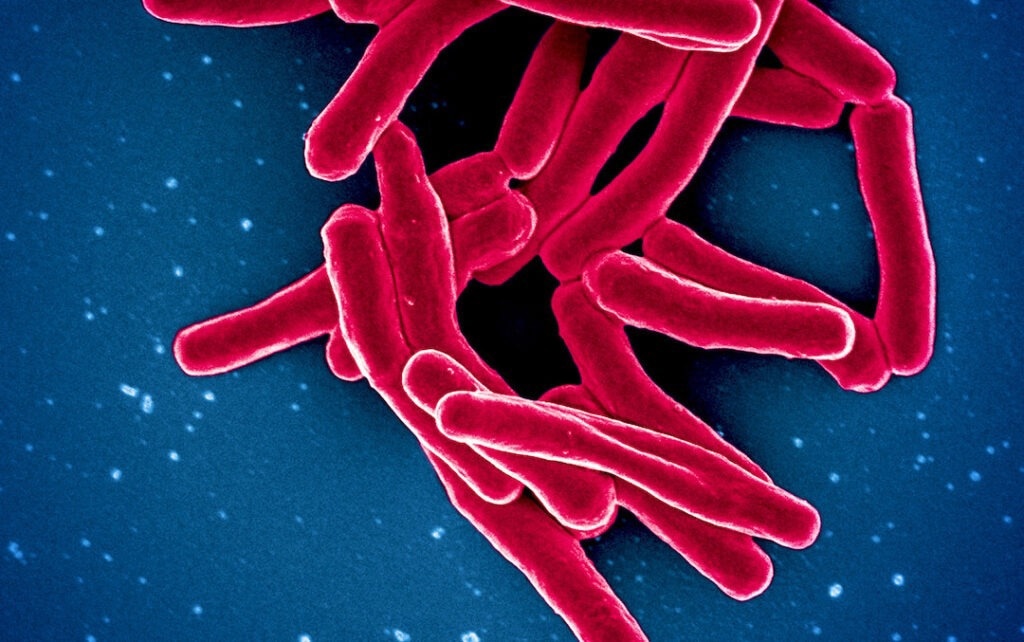Researchers find promising targets for a tuberculosis vaccine and medication by monitoring T cell activity.
 Scanning electron micrograph of Mycobacterium tuberculosis particles (colorized red), the bacterium which causes TB. Image Credit: NIAID
Scanning electron micrograph of Mycobacterium tuberculosis particles (colorized red), the bacterium which causes TB. Image Credit: NIAID
The goal of the La Jolla Institute for Immunology (LJI) is to direct the creation of novel medication treatments and vaccines against tuberculosis.
Important hints regarding how human T cells fight Mycobacterium tuberculosis - the bacterium that causes tuberculosis - have now been discovered by a group of LJI scientists. Their research was published in Nature Communications.
This research gives us a better understanding of T cell responses to different stages in tuberculosis infection and helps us figure out is there are additional diagnostic targets, vaccine targets, or drug candidates to help people with the disease.”
Cecilia Lindestam Arlehamn PhD, Research Assistant and Professor, La Jolla Institute for Immunology
Arlehamn led the new research in collaboration with LJI Professors Bjoern Peters, PhD, and Alessandro Sette, Dr.Biol.Sci.
The Urgent Need for TB Research
According to the World Health Organization, more than 1.3 million people died of TB in 2022, making it the second-leading infectious cause of death after COVID-19.
Lindestam Arlehamn says, “TB is a huge problem in many countries.”
At the moment, bacille Calmette-Guerin (BCG) vaccination offers protection against certain severe cases of tuberculosis. Unfortunately, pulmonary TB, which can also be fatal, is not always prevented by BCG. TB can be treated with drugs, but a growing number of cases globally have demonstrated resistance to these treatments.
Lindestam Arlehamn and colleagues are studying T cells to help stop tuberculosis. T cells are essential for preventing the body's infections from spreading. T cells search for particular markers, known as peptide sequences, that are associated with the pathogen rather than attacking the pathogen as a whole. Scientists refer to a region of a pathogen's peptide sequence that a T cell recognizes as an “epitope.”
Finding T cell epitopes provides scientists with critical information about how to target the same epitopes with vaccines and drug treatments in order to halt a pathogen.
T Cells Take Aim at a Range of TB Epitopes
The patients’ samples for the new study came from those who were in the middle of active tuberculosis treatment. The study participants from Peru, Sri Lanka, and Moldova provided these samples. The researchers aimed to capture a wide diversity of genetics and environmental factors that can affect immune system activity by examining T cells in patients from three continents.
The LJI team found 137 distinct T cell epitopes in their analysis. It was discovered that T cells present in two or more patients targeted 16% of these epitopes. The immune system seemed to be trying very hard to focus on these epitopes.
Which of these epitopes might make good targets for upcoming TB vaccinations and medication therapies will be the subject of future research by Lindestam Arlehamn’s lab.
A Step Toward Better Diagnostics
Additionally, the new study is a step toward identifying TB cases before they become fatal.
A person can be exposed to Mycobacterium tuberculosis through the air without ever realizing it. Many people do not experience any symptoms for months or years after being exposed. This “latent,” or inactive TB may become active if an individual’s immune system is compromised, as might happen during pregnancy or as a result of an HIV infection.
For the new study, the researchers also compared samples from active TB patients with samples from healthy individuals. The scientists uncovered key differences in T cell reactivity between the two groups.
For the first time, we could distinguish people with active TB versus those that have been exposed to TB—or unexposed individuals.”
Cecilia Lindestam Arlehamn PhD, Research Assistant and Professor, La Jolla Institute for Immunology
Lindestam Arlehamn says it may be possible to develop diagnostics that detect this tell-tale T cell reactivity that marks a person’s shift from latent to active TB.
Lindestam Arlehamn says “Can we use this peptide pool to look for high-risk individuals and try and follow them over time?”
Source:
Journal reference:
Panda, S., et al. (2024) Identification of differentially recognized T cell epitopes in the spectrum of tuberculosis infection. Nature Communications. doi.org/10.1038/s41467-024-45058-9